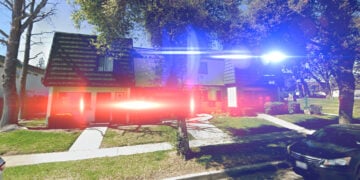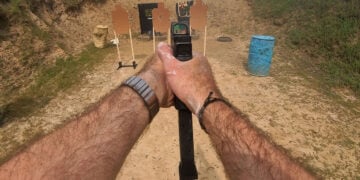After a while, drills that we shoot all the time can get a bit stale. So if you are looking for something a little bit different, the BFM Drill is an excellent way to add some spice to common drills. I first learned of this drill from Earnest Langdon; he got it from Ken Hackathorn, one of the godfathers of modern firearms training. Ken supposedly is not the originator of the drill either, but I am uncertain where he got it from, so we will say it is his drill. He at least is the one who seems to have popularized the drill.
What is the BFM Drill?
The BFM is three drills smashed together in a single string of fire and shot for a single score. It starts with a Bill Drill to the center target of a three target array, a FAST on the left target, and a Mozambique, or failure drill, on the right target. The targets are spaced about 2 yards apart, and the drill is shot from 7 yards. Using IDPA targets calculate points down and add 1 second per point down. I maintained strict IDPA scoring, requiring hits inside the 4” -0 zone for headshots. I do not believe Ken scores it quite that tight, but I prefer the additional challenge.
My BFM Drill Run
According to Ken Hackathorn, “passing” the drill is shooting it in 20 seconds or less. That time might be a little generous for the more skilled shooters among us, so Ken suggest further skill brackets can be broken down as follows
| Ninja Column 1 | Ninja Column 2 |
|---|---|
| Less than 11 Seconds | A |
| 11-14 Seconds | B |
| 14-17 Seconds | C |
| 17-20 Seconds | D |
The BFM hits quite a few skill areas. There are significant speed shifts in the drill, especially going from the Bill Drill to the FAST. I find that transition from the gas pedal to the floor to very measured precision to be quite difficult. There is a slide lock reload, a couple of transitions, and of course a draw. The drill is very well rounded. With appropriately careful and detailed note taking you can use it quite well to track performance over time.
Setting Up the Bill Drill
Now one significant downside to the BFM drill is the logistics of setting it up. If you shoot on an outdoor range, it isn’t that big of a deal, assuming you can have an entire bay to yourself. However, not everyone has access to a nice range facility. For those people stuck on indoor ranges or restrictive outdoor ranges, they can still adapt the drill to that environment. All that we have to do to make it work on an indoor range is to condense the targets into a single target.
There are a lot of ways you can set up the BFM Drill at an indoor range. One of the simplest is to take two 3”x5” index cards and orient them vertically. These will serve as the targets for our body shots. Take a third 3”x5” card and fold it in half; this will serve as our headshot target. Obviously shooting 3”x5” index cards at 7 yards would be a significantly higher accuracy standard. To figure out what distance we should shoot at we can use this formula: (size of the full-size target)/(distance to target)x(distance to reduced target)=size of the reduced target. This will give us a rough approximation which should be good enough. In the case of 3”x5” cards, we need to shoot the drill at about 4.5 yards. The transitions, of course, are smaller. We also lose the ability to compare our results to others directly, but still, maintain the general concept of the drill.
So get out and try the BFM Drill if you can, let us know how you do in the comments. It is a pretty fun drill with some real value in it.









